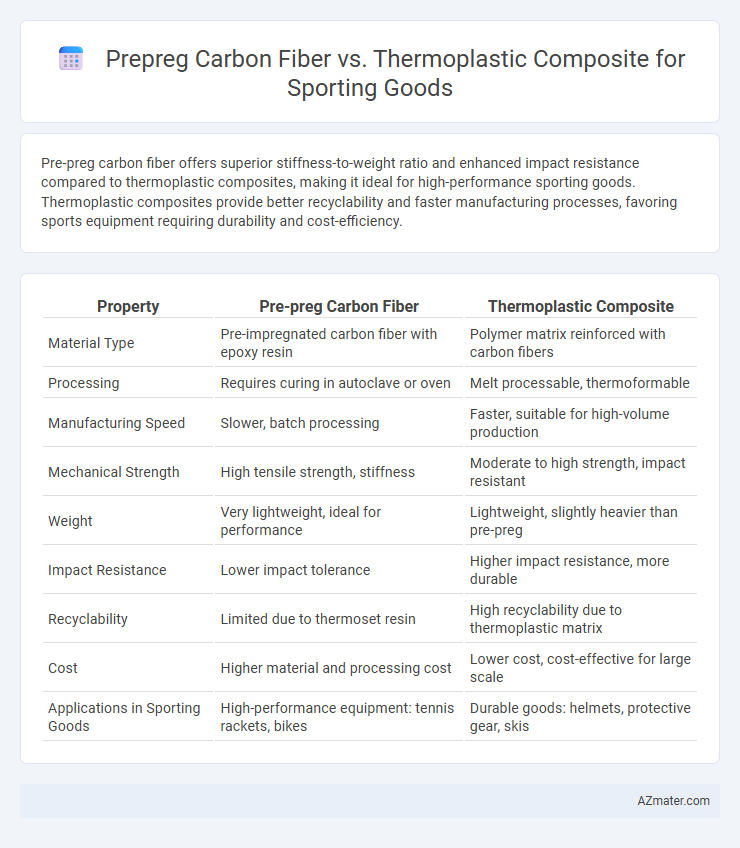Pre-preg carbon fiber offers superior stiffness-to-weight ratio and enhanced impact resistance compared to thermoplastic composites, making it ideal for high-performance sporting goods. Thermoplastic composites provide better recyclability and faster manufacturing processes, favoring sports equipment requiring durability and cost-efficiency.
Table of Comparison
| Property | Pre-preg Carbon Fiber | Thermoplastic Composite |
|---|---|---|
| Material Type | Pre-impregnated carbon fiber with epoxy resin | Polymer matrix reinforced with carbon fibers |
| Processing | Requires curing in autoclave or oven | Melt processable, thermoformable |
| Manufacturing Speed | Slower, batch processing | Faster, suitable for high-volume production |
| Mechanical Strength | High tensile strength, stiffness | Moderate to high strength, impact resistant |
| Weight | Very lightweight, ideal for performance | Lightweight, slightly heavier than pre-preg |
| Impact Resistance | Lower impact tolerance | Higher impact resistance, more durable |
| Recyclability | Limited due to thermoset resin | High recyclability due to thermoplastic matrix |
| Cost | Higher material and processing cost | Lower cost, cost-effective for large scale |
| Applications in Sporting Goods | High-performance equipment: tennis rackets, bikes | Durable goods: helmets, protective gear, skis |
Introduction to Advanced Composites in Sporting Goods
Pre-preg carbon fiber composites offer superior strength-to-weight ratios and excellent stiffness, making them ideal for high-performance sporting goods like tennis rackets and bicycle frames. Thermoplastic composites provide enhanced impact resistance and faster manufacturing cycles, which benefits products requiring durability and rapid production such as protective helmets and sports apparel components. Both materials advance athletic performance through tailored mechanical properties, but selection depends on specific application demands including weight, strength, and manufacturing efficiency.
What Is Pre-preg Carbon Fiber?
Pre-preg carbon fiber consists of carbon fibers pre-impregnated with a controlled amount of resin, typically epoxy, which enhances mechanical properties and ensures uniform resin distribution. This material offers superior strength-to-weight ratio and excellent fatigue resistance, making it ideal for high-performance sporting goods such as tennis rackets, bicycle frames, and ski equipment. Compared to thermoplastic composites, pre-preg carbon fiber provides better structural integrity and dimensional stability under dynamic loads.
Understanding Thermoplastic Composites
Thermoplastic composites in sporting goods offer superior impact resistance and faster manufacturing cycles compared to pre-preg carbon fiber, enhancing durability and production efficiency. Their recyclability and ability to be reshaped under heat provide sustainable advantages and design flexibility for high-performance equipment. Innovations in thermoplastic matrices like PEEK and PPS contribute to improved toughness and lightweight properties critical for competitive sports applications.
Strength and Performance Comparison
Pre-preg carbon fiber offers superior strength-to-weight ratio and stiffness compared to thermoplastic composites, making it ideal for high-performance sporting goods requiring maximum durability and responsiveness. Thermoplastic composites provide enhanced impact resistance and better toughness, allowing for greater flexibility and resilience during repeated use or extreme conditions. Athletes often prefer pre-preg carbon fiber for precision and power, while thermoplastic composites excel in applications demanding energy absorption and long-term wear resistance.
Weight and Flexibility Differences
Pre-preg carbon fiber offers superior weight reduction and enhanced stiffness, making it ideal for high-performance sporting goods demanding lightweight durability. Thermoplastic composites provide greater flexibility and impact resistance, allowing better energy absorption and shape adaptability during dynamic movements. Weight advantages of pre-preg carbon fiber enable faster, more agile gear, while thermoplastics prioritize comfort and resilience without significant weight increase.
Manufacturing Processes and Scalability
Pre-preg carbon fiber utilizes advanced resin-impregnated fibers cured under heat and pressure, offering superior strength-to-weight ratios and consistent quality for high-performance sporting goods. Thermoplastic composites employ melt-processable polymers that enable faster cycle times and easier recycling, making them ideal for scalable production with complex geometries. Manufacturing scalability favors thermoplastics due to shorter curing times and adaptability to automated processes, while pre-pregs excel in applications demanding precision and structural integrity.
Durability and Impact Resistance
Pre-preg carbon fiber offers superior durability and impact resistance with its tightly woven fibers and high resin content, making it ideal for high-performance sporting goods subjected to repeated stress. Thermoplastic composites provide excellent impact resistance due to their inherent flexibility and ability to absorb and dissipate energy, enhancing toughness in dynamic sports environments. The choice between the two depends on the sport's specific demands for weight, stiffness, and resilience under impact conditions.
Cost Implications for Sporting Equipment
Pre-preg carbon fiber offers superior strength-to-weight ratios and consistent quality, making it a preferred choice for high-performance sporting equipment but comes with higher material and processing costs due to its specialized curing requirements. Thermoplastic composites provide cost-effective manufacturing advantages, including faster production cycles and recyclability, which reduces long-term expenses for mass-produced sports goods. Budget-conscious manufacturers often balance initial investment in pre-preg carbon fiber against the scalable, cost-efficient benefits of thermoplastic composites to optimize performance and profitability.
Sustainability and Recycling Considerations
Pre-preg carbon fiber composites offer superior strength-to-weight ratios for sporting goods but present recycling challenges due to thermoset matrices that resist reprocessing. Thermoplastic composites enable easier recycling and reshaping, supporting circular economy goals with lower environmental impact during end-of-life management. Choosing thermoplastics enhances sustainability in sports equipment by allowing material recovery and reducing landfill waste compared to pre-preg carbon fiber-based products.
Best Applications: Choosing the Right Composite for Sporting Goods
Pre-preg carbon fiber composites excel in high-performance sporting goods such as racing bicycles, tennis rackets, and golf clubs due to their superior strength-to-weight ratio and precise fiber alignment, enabling enhanced stiffness and responsiveness. Thermoplastic composites offer excellent impact resistance and recyclability, making them ideal for protective gear like helmets, guards, and pads where durability and safety are paramount. Selecting the right composite depends on the specific application requirements, balancing factors like performance, weight, impact resistance, and manufacturing complexity.

Infographic: Pre-preg Carbon Fiber vs Thermoplastic Composite for Sporting Good
 azmater.com
azmater.com